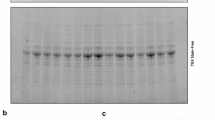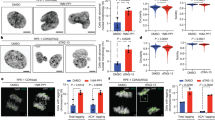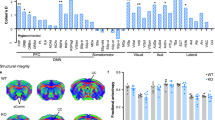Abstract
Cyclin-dependent kinase 5 (CDK5) and cyclin-dependent kinase 5, regulatory subunit 1 (CDK5R1), encoding CDK5 activator p35, have a fundamental role in central nervous system (CNS) development and function, and are involved in the pathogenesis of several neurodegenerative disorders, thus constituting strong candidate genes for the onset of intellectual disability (ID). We carried out a mutation screening of CDK5 and CDK5R1 coding regions and CDK5R1 3′-UTR on a cohort of 360 patients with non-syndromic ID (NS-ID) using denaturing high performance liquid chromatography (DHPLC) and direct sequencing. We found one novel silent mutation in CDK5 and one novel silent mutation in CDK5R1 coding regions, three novel intronic variations in CDK5, not causing any splicing defect, and four novel heterozygous variations in CDK5R1 3′-UTR. None of these variations was present in 450 healthy controls and single-nucleotide polymorphism (SNP) databases. The functional study of CDK5R1 p.A108V mutation evidenced an impaired p35 cleavage by the calcium-dependent protease calpain. Moreover, luciferase constructs containing the CDK5R1 3′-UTR mutations showed altered gene expression levels. Eight known polymorphisms were also identified displaying different frequencies in NS-ID patients compared with the controls. In particular, the minor allele of CDK5R1 3′-UTR rs735555 polymorphism was associated with increased risk for NS-ID. In conclusion, our data suggest that mutations and polymorphisms in CDK5 and CDK5R1 genes may contribute to the onset of the NS-ID phenotype.
Similar content being viewed by others
Log in or create a free account to read this content
Gain free access to this article, as well as selected content from this journal and more on nature.com
or
References
Leonard, H. & Wen, X. The epidemiology of mental retardation: challenges and opportunities in the new millennium. Ment. Retard. Dev. Disabil. Res. Rev. 8, 117–134 (2002).
Ropers, H. H. Genetics of intellectual disability. Curr. Opin. Genet. Dev. 18, 241–250 (2008).
Bhalla, K., Luo, Y., Buchan, T., Beachem, M. A., Guzauskas, G. F., Ladd, S. et al. Alterations in CDH15 and KIRREL3 in patients with mild to severe intellectual disability. Am. J. Hum. Genet. 83, 703–713 (2008).
Lubs, H. A., Stevenson, R. E. & Schwartz, C. E. Fragile X and X-linked intellectual disability: four decades of discovery. Am. J. Hum. Genet. 90, 579–590 (2012).
Musante, L. & Ropers, H. H. Genetics of recessive cognitive disorders. Trends Genet. 30, 32–39 (2014).
Vissers, L. E., de Ligt, J., Gilissen, C., Janssen, I., Steehouwer, M., de Vries, P. et al. A de novo paradigm for mental retardation. Nat. Genet. 42, 1109–1112 (2010).
Hamdan, F. F., Gauthier, J., Araki, Y., Lin, D. T., Yoshizawa, Y., Higashi, K. et al. Excess of de novo deleterious mutations in genes associated with glutamatergic systems in nonsyndromic intellectual disability. Am. J. Hum. Genet. 88, 306–316 (2011).
Hamdan, F. F., Gauthier, J., Spiegelman, D., Noreau, A., Yang, Y., Pellerin, S. et al. Mutations in SYNGAP1 in autosomal nonsyndromic mental retardation. N. Engl. J. Med. 360, 599–605 (2009).
Hamdan, F. F., Piton, A., Gauthier, J., Lortie, A., Dubeau, F., Dobrzeniecka, S. et al. De novo STXBP1 mutations in mental retardation and nonsyndromic epilepsy. Ann. Neurol. 65, 748–753 (2009).
Jessberger, S., Gage, F. H., Eisch, A. J. & Lagace, D. C. Making a neuron: Cdk5 in embryonic and adult neurogenesis. Trends Neurosci. 32, 575–582 (2009).
Shelton, S. B. & Johnson, G. V. Cyclin-dependent kinase-5 in neurodegeneration. J. Neurochem. 88, 1313–1326 (2004).
Magen, D., Ofir, A., Berger, L., Goldsher, D., Eran, A., Katib, N. et al. Autosomal recessive lissencephaly with cerebellar hypoplasia is associated with a loss-of-function mutation in CDK5. Hum. Genet. 134, 305–314 (2015).
Venturin, M., Guarnieri, P., Natacci, F., Stabile, M., Tenconi, R., Clementi, M. et al. Mental retardation and cardiovascular malformations in NF1 microdeleted patients point to candidate genes in 17q11.2. J. Med. Genet. 41, 35–41 (2004).
Kalathur, R. K., Hernandez-Prieto, M. A. & Futschik, M. E. Huntington's disease and its therapeutic target genes: a global functional profile based on the HD Research Crossroads database. BMC Neurol. 12, 47 (2012).
Bond, J., Roberts, E., Springell, K., Lizarraga, S. B., Scott, S., Higgins, J. et al. A centrosomal mechanism involving CDK5RAP2 and CENPJ controls brain size. Nat. Genet. 8, 353–355 (2005).
Hassan, M. J., Khurshid, M., Azeem, Z., John, P., Ali, G., Chishti, M. S. et al. Previously described sequence variant in CDK5RAP2 gene in a Pakistani family with autosomal recessive primary microcephaly. BMC Med. Genet. 8, 58 (2007).
Pagnamenta, A. T., Murray, J. E., Yoon, G., Sadighi Akha, E., Harrison, V., Bicknell, L. S. et al. A novel nonsense CDK5RAP2 mutation in a Somali child with primary microcephaly and sensorineural hearing loss. Am. J. Med. Genet. A 8, 2577–2582 (2012).
Tan, C. A., Topper, S., Ward Melver, C., Stein, J., Reeder, A., Arndt, K. et al. The first case of CDK5RAP2-related primary microcephaly in a non-consanguineous patient identified by next generation sequencing. Brain. Dev. 36, 351–355 (2014).
Venturin, M., Moncini, S., Villa, V., Russo, S., Bonati, M. T., Larizza, L. et al. Mutations and novel polymorphisms in coding regions and UTRs of CDK5R1 and OMG genes in patients with non-syndromic mental retardation. Neurogenetics 7, 59–66 (2006).
Moncini, S., Bevilacqua, A., Venturin, M., Fallini, C., Ratti, A., Nicolin, A. et al. The 3′ untranslated region of human Cyclin-Dependent Kinase 5 Regulatory subunit 1 contains regulatory elements affecting transcript stability. BMC Mol. Biol. 8, 111 (2007).
Baralle, M., Baralle, D., De Conti, L., Mattocks, C., Whittaker, J., Knezevich, A. et al. Identification of a mutation that perturbs NF1 a gene splicing using genomic DNA samples and a minigene assay. J. Med. Genet. 40, 220–222 (2003).
Pagani, F., Buratti, E., Stuani, C., Romano, M., Zuccato, E., Niksic, M. et al. Splicing factors induce cystic fibrosis transmembrane regulator exon 9 skipping through a nonevolutionary conserved intronic element. J. Biol. Chem. 275, 21041–21047 (2000).
Iijima, K., Ando, K., Takeda, S., Satoh, Y., Seki, T., Itohara, S. et al. Neuron-specific phosphorylation of Alzheimer’s beta-amyloid precursor protein by cyclin-dependent kinase 5. J. Neurochem. 75, 1085–1091 (2000).
Ko, J., Humbert, S., Bronson, R. T., Takahashi, S., Kulkarni, A. B., Li, E. et al. p35 and p39 are essential for cyclin-dependent kinase 5 function during neurodevelopment. J. Neurosci. 21, 6758–6771 (2001).
Su, S. C. & Tsai, L. H. Cyclin-dependent kinases in brain development and disease. Annu. Rev. Cell. Dev. Biol. 27, 465–491 (2011).
Ohshima, T., Ward, J. M., Huh, C. G., Longenecker, G., Veeranna, Pant, H. C., Brady, R. O. et al. Targeted disruption of the cyclin-dependent kinase 5 gene results in abnormal corticogenesis, neuronal pathology and perinatal death. Proc. Natl Acad. Sci. USA 93, 11173–11178 (1996).
Chae, T., Kwon, Y. T., Bronson, R., Dikkes, P., Li, E. & Tsai, L. H. Mice lacking p35, a neuronal specific activator of Cdk5, display cortical lamination defects, seizures, and adult lethality. Neuron 18, 29–42 (1997).
Wenzel, H. J., Robbins, C. A., Tsai, L. H. & Schwartzkroin, P. A. Abnormal morphological and functional organization of the hippocampus in a p35 mutant model of cortical dysplasia associated with spontaneous seizures. J. Neurosci. 21, 983–998 (2001).
Patrick, G. N., Zukerberg, L., Nikolic, M., de la Monte, S., Dikkes, P. & Tsai, L. H. Conversion of p35 to p25 deregulates Cdk5 activity and promotes neurodegeneration. Nature 402, 615–622 (1999).
Engmann, O., Hortobagyi, T., Thompson, A. J., Guadagno, J., Troakes, C., Soriano, S. et al. Cyclin-dependent kinase 5 activator p25 is generated during memory formation and is reduced at an early stage in Alzheimer's disease. Biol. Psychiatry 70, 159–168 (2011).
Engmann, O., Hortobagyi, T., Pidsley, R., Troakes, C., Bernstein, H. G., Kreutz, M. R. et al. Schizophrenia is associated with dysregulation of a Cdk5 activator that regulates synaptic protein expression and cognition. Brain 134, 2408–2421 (2011).
Dhavan, R. & Tsai, L. H. A decade of CDK5. Nat. Rev. Mol. Cell. Biol. 2, 749–759 (2001).
Bagga, J. S. & D'Antonio, L. A. Role of conserved cis-regulatory elements in the post-transcriptional regulation of the human MECP2 gene involved in autism. Hum. Genomics 7, 19 (2013).
Conne, B., Stutz, A. & Vassalli, J. D. The 3′ untranslated region of messenger RNA: a molecular 'hotspot' for pathology? Nat. Med. 6, 637–641 (2000).
Huang, L., Jolly, L. A., Willis-Owen, S., Gardner, A., Kumar, R., Douglas, E. et al. A noncoding, regulatory mutation implicates HCFC1 in nonsyndromic intellectual disability. Am. J. Hum. Genet. 91, 694–702 (2012).
Reamon-Buettner, S. M., Cho, S. H. & Borlak, J. Mutations in the 3′-untranslated region of GATA4 as molecular hotspots for congenital heart disease (CHD). BMC Med. Genet. 8, 38 (2007).
Chatterjee, S. & Pal, J. K. Role of 5′- and 3′-untranslated regions of mRNAs in human diseases. Biol. Cell 101, 251–262 (2009).
Michalova, E., Vojtesek, B. & Hrstka, R. Impaired pre-mRNA processing and altered architecture of 3′ untranslated regions contribute to the development of human disorders. Int. J. Mol. Sci. 14, 15681–15694 (2013).
Moncini, S., Salvi, A., Zuccotti, P., Viero, G., Quattrone, A., Barlati, S. et al. The role of miR-103 and miR-107 in regulation of CDK5R1 expression and in cellular migration. PLoS ONE 6, e20038 (2011).
Zuccotti, P., Colombrita, C., Moncini, S., Barbieri, A., Lunghi, M., Gelfi, C. et al. hnRNPA2/B1 and nELAV proteins bind to a specific U-rich element in CDK5R1 3′-UTR and oppositely regulate its expression. Biochim. Biophys. Acta 1839, 506–516 (2014).
Mateo, I., Vazquez-Higuera, J. L., Sanchez-Juan, P., Rodriguez-Rodriguez, E., Infante, J., Garcia-Gorostiaga, I. et al. Epistasis between tau phosphorylation regulating genes (CDK5R1 and GSK-3beta) and Alzheimer's disease risk. Acta Neurol. Scand. 120, 130–133 (2009).
Das, G., Misra, A. K., Das, S. K., Ray, K. & Ray, J. Role of tau kinases (CDK5R1 and GSK3B) in Parkinson's disease: a study from India. Neurobiol. Aging 33, 1485.e9–15 (2012).
Acknowledgements
We thank Dr Rosanna Asselta for providing the DNA samples from control individuals.
Author information
Authors and Affiliations
Corresponding author
Ethics declarations
Competing interests
The authors declare no conflict of interest.
Rights and permissions
About this article
Cite this article
Moncini, S., Castronovo, P., Murgia, A. et al. Functional characterization of CDK5 and CDK5R1 mutations identified in patients with non-syndromic intellectual disability. J Hum Genet 61, 283–293 (2016). https://doi.org/10.1038/jhg.2015.144
Received:
Revised:
Accepted:
Published:
Issue date:
DOI: https://doi.org/10.1038/jhg.2015.144
This article is cited by
-
Cyclin-dependent kinases and rare developmental disorders
Orphanet Journal of Rare Diseases (2020)
-
Tale of the Good and the Bad Cdk5: Remodeling of the Actin Cytoskeleton in the Brain
Molecular Neurobiology (2018)
-
Characterization of the CDK5 gene in Apis cerana cerana (AccCDK5) and a preliminary identification of its activator gene, AccCDK5r1
Cell Stress and Chaperones (2018)



